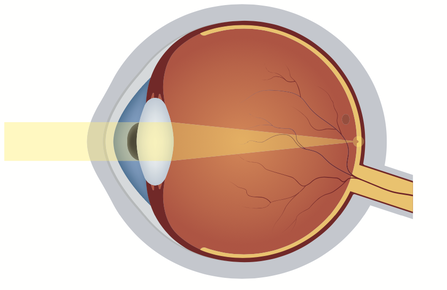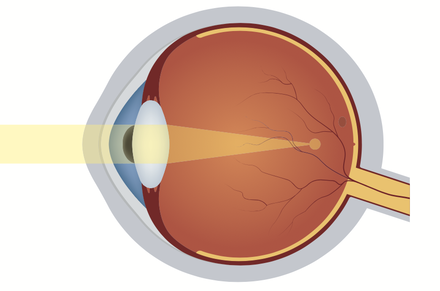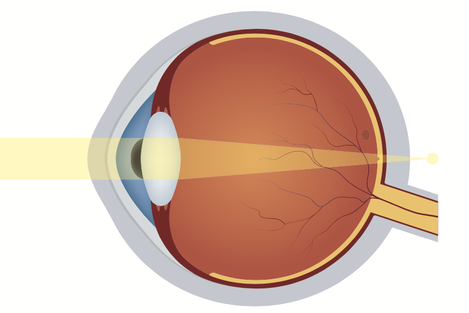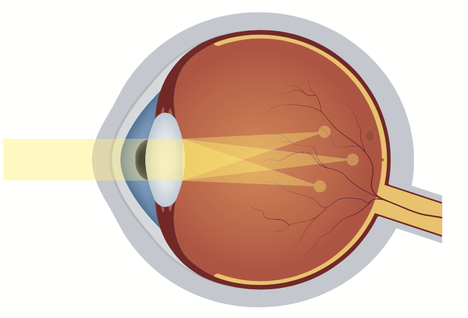Normal vision
Normal vision if often referred to as being able to see 20/20 on the eye chart without the use of glasses or contact lenses. The eye is shaped perfectly so that light entering focuses directly on the cornea.
MYOPIA (NEARSIGHTEDNESS)
A common vision condition in which people can see close objects clearly, but objects farther away appear blurred.
Myopia occurs when the eyeball is too long and as a result, the light entering the eye isn't focused correctly on the retina. There is significant evidence that many people inherit myopia, if one or both parents are nearsighted, there is an increased chance their children will be nearsighted.
Individuals who spend considerable time reading, working at a computer, playing video games or doing other intense close visual work may be more likely to develop myopia. In fact, high levels of screen time on smart devices is associated with around a 30% higher risk of myopia and, when combined with excessive computer use, that risk rose to around 80%.
Children who are at high risk of progressive myopia may benefit from treatment options that have been shown to reduce the progression of myopia. These treatments include the prescription of bifocal spectacle or contact lenses, orthokeratology, eye drops, or a combination of these. Individuals with high myopia are at a greater risk of developing cataracts, glaucoma and myopic degeneration. Yearly eye examinations, especially during childhood are important for early diagnosis and beginning myopia management treatment may help to preserve eye health.
Myopia occurs when the eyeball is too long and as a result, the light entering the eye isn't focused correctly on the retina. There is significant evidence that many people inherit myopia, if one or both parents are nearsighted, there is an increased chance their children will be nearsighted.
Individuals who spend considerable time reading, working at a computer, playing video games or doing other intense close visual work may be more likely to develop myopia. In fact, high levels of screen time on smart devices is associated with around a 30% higher risk of myopia and, when combined with excessive computer use, that risk rose to around 80%.
Children who are at high risk of progressive myopia may benefit from treatment options that have been shown to reduce the progression of myopia. These treatments include the prescription of bifocal spectacle or contact lenses, orthokeratology, eye drops, or a combination of these. Individuals with high myopia are at a greater risk of developing cataracts, glaucoma and myopic degeneration. Yearly eye examinations, especially during childhood are important for early diagnosis and beginning myopia management treatment may help to preserve eye health.
hyperopia (farsightedness)
A common vision condition in which people can see far objects clearly, but objects closer appear blurred.
Hyperopia occurs when the eyeball is too short and as a result, the light entering the eye isn't focused correctly on the retina. Uncorrected Hyperopia may cause you to squint or strain your eyes to maintain focus. This can lead to eyestrain and headaches. Hyperopia usually presents at childbirth and tends to run in families. Some children with farsightedness may develop a lazy eye (amblyopia). Specially designed eyeglasses that correct for part or all of the farsightedness may treat this problem before the lazy eye becomes permanent.
Hyperopia occurs when the eyeball is too short and as a result, the light entering the eye isn't focused correctly on the retina. Uncorrected Hyperopia may cause you to squint or strain your eyes to maintain focus. This can lead to eyestrain and headaches. Hyperopia usually presents at childbirth and tends to run in families. Some children with farsightedness may develop a lazy eye (amblyopia). Specially designed eyeglasses that correct for part or all of the farsightedness may treat this problem before the lazy eye becomes permanent.
Astigmatism
A common vision condition that occurs when your cornea is irregularly shaped and prevents light from properly focusing on the retina. When you have astigmatism, the surface of the cornea is shaped more like a football instead of round like a basketball and the eye is unable to focus light rays to a single point. In this case, vision becomes out of focus at any distance.
Astigmatism is hereditary and usually presents at birth, it can also occur after surgery or trauma to the eye. In addition, the curvature of the lens inside the eye can change, resulting in an increase or decrease in astigmatism. This change frequently occurs in adulthood and can precede the development of naturally occurring cataracts.
Astigmatism is hereditary and usually presents at birth, it can also occur after surgery or trauma to the eye. In addition, the curvature of the lens inside the eye can change, resulting in an increase or decrease in astigmatism. This change frequently occurs in adulthood and can precede the development of naturally occurring cataracts.
Complete Primary Eyecare
Hubbard Centre One
30 N Main Street Hubbard, OH 44425 |
Hours
Monday: 8:00 am - 4:30 pm Tuesday: 8:00 am - 4:30 pm Wednesday: 8:00 am - 4:30 pm Thursday: 8:00 am - 4:30 pm Friday: By appointment only Saturday: Closed Sunday: Closed |







